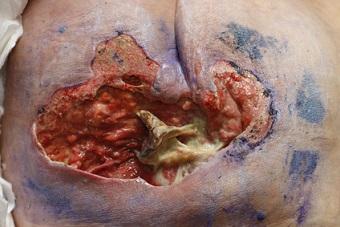The Impact of a WOC Journal Club on Pressure Injury Prevention and Staff Engagement
November 8, 2018
Wound, ostomy, continence (WOC) nurses wear many hats. A significant role that we play is that of an educator, both with our patients and with our staff. I'm sure we've all heard "How on earth did you ever get interested in wounds? What made you want to be a wound specialist?" or similar comments. There are so many specialties in nursing, so why this one? For me, it is about helping others.
As a WOC nurse, you have the ability to make such an impact in the lives of others and, too often, continue to affect their lives on a regular basis whether it be through visits in an outpatient wound clinic, teaching a patient and their loved one how to manage their new ostomy, or watching as someone is once again able to enjoy life because of better management of incontinence.
Additionally, we affect nurses. Our nurses look to us as the expert, support, liaison, and educator. Nurses don't always get a ton of WOC knowledge in nursing school; the first time they have to change a complex dressing, manage a fistula, or troubleshoot a leaky ostomy pouch can definitely be an intimidating experience. Therefore, it is important for us to engage them and to share our knowledge.
Interdisciplinary Sharing and Team Building
I've found that by setting up a monthly journal club, I have really been able to engage staff on an interdisciplinary level. My journal club is open to nurses (RNs and LPNs), CNAs, mid-level providers or APRNs, physicians, therapy, dietitians, students, pharmacy, infectious disease, general surgery, podiatry, plastic surgery, dermatology, and other specialties. I often get a mix of disciplines and encourage others to take the role as facilitator. Depending on who facilitates, we have a great mix of topics. Some things that we have discussed are the impact of pressure injuries on quality of life, management of osteomyelitis from a pharmacological perspective or case study, skin tear management, skin tears or wounds and falls, the impact of medications on wound healing (or not healing), and others!
My topics are selected by the group or by identifying trends or knowledge gaps in the facility based on interviews with nurses and performance improvement measures... or, sometimes, just by suggestions from attendees related to interesting topics. Our next topic will be calciphylaxis. This has always been such a fascinating disease to me that requires an interdisciplinary team for management, along with many different modalities for treatment. The multitude of topics keeps nurses engaged and on their toes, but it also keeps our group interdisciplinary. It is awesome to have input from all levels and providers that we interact with on a daily basis.
A participant recently made a super important point regarding wound management... it takes teamwork! This could not be more accurate. It is so important to realize and acknowledge the work that all members of our team do... from the CNAs who provide the direct bedside care and notify us with changes in skin condition, to the providers who write for the medications that may help or impede healing, the pharmacists who review the medications or recommend changes, therapy, dietitians, specialty services (general surgery, podiatry, dermatology, plastic surgery, vascular surgery, etc.), and, of course, leadership who ultimately enforces and promotes a culture of prevention of pressure injuries.
Education in Pressure Injury Prevention
I've mentioned this in past blogs, but support is needed from leadership all the way through the nursing chain of command. Support and staff engagement are two of the keys to pressure injury prevention. We have multiple tools in our toolbox that will help with prevention, but the key is really the bedside staff and all of the players in our interdisciplinary team. If we engage and support our staff through activities that pique their interest, it will keep them on their toes and make them knowledgeable about the most up-to-date and evidence-based WOC nursing practices.
Not only do staff enjoy coming to the journal club, but also it has created a culture of teamwork and identifying all pieces of the wound care puzzle. It really reinforces the importance of treating the whole person, not just the hole in the person – another phrase I like to emphasize!
Conclusion
WOC journal clubs are a helpful activity that promotes teambuilding and teamwork. I’m always interested in new and creative ideas to get and keep staff involved in WOC nursing practices. Empowering and educating our frontline staff are definitely important measures in terms of pressure injury prevention. Teamwork, staff engagement, and taking pride in your work will undoubtedly make for a successful pressure injury prevention program!
About the Author
Holly is a board certified gerontological nurse and advanced practice wound, ostomy, and continence nurse coordinator at The Department of Veterans Affairs Medical Center in Cleveland, Ohio. She has a passion for education, teaching, and our veterans. Holly has been practicing in WOC nursing for approximately six years. She has much experience with the long-term care population and chronic wounds as well as pressure injuries, diabetic ulcers, venous and arterial wounds, surgical wounds, radiation dermatitis, and wounds requiring advanced wound therapy for healing. Holly enjoys teaching new nurses about wound care and, most importantly, pressure injury prevention. She enjoys working with each patient to come up with an individualized plan of care based on their needs and overall medical situation. She values the importance of taking an interprofessional approach with wound care and prevention overall, and involves each member of the health care team as much as possible. She also values the significance of the support of leadership within her facility and the overall impact of great teamwork for positive outcomes.
The views and opinions expressed in this blog are solely those of the author, and do not represent the views of WoundSource, HMP Global, its affiliates, or subsidiary companies.












Follow WoundSource
Tweets by WoundSource